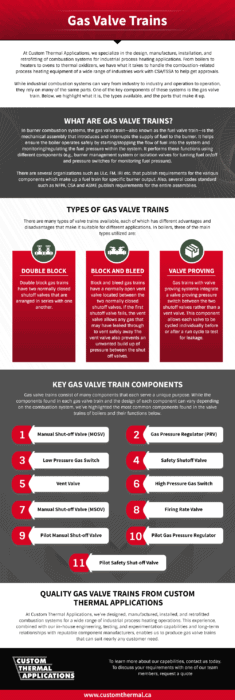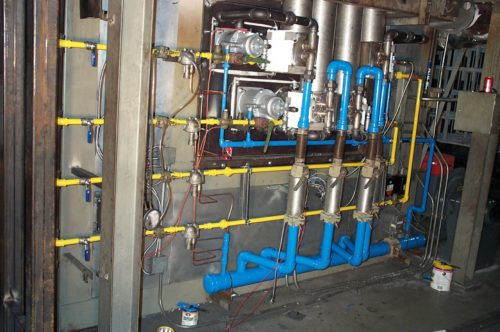At Custom Thermal Applications, we specialize in the design, manufacture, installation, and retrofitting of combustion systems for industrial process heating applications. From boilers to heaters to ovens to thermal oxidizers, we have what it takes to handle the combustion-related process heating equipment of a wide range of industries work with CSA/TSSA to help get approvals.
While industrial combustion systems can vary from industry to industry and operation to operation, they rely on many of the same parts. One of the key components of these systems is the gas valve train. Below, we highlight what it is, the types available, and the parts that make it up.
What Are Gas Valve Trains?
In burner combustion systems, the gas valve train—also known as the fuel valve train—is the mechanical assembly that introduces and interrupts the supply of fuel to the burner. It helps ensure the boiler operates safely by starting/stopping the flow of fuel into the system and monitoring/regulating the fuel pressure within the system. It performs these functions using different components (e.g., burner management system or isolation valves for turning fuel on/off and pressure switches for monitoring fuel pressure).
There are several organizations such as ULc, FM, IRI etc. that publish requirements for the various components which make up a fuel train for specific burner output. Also, several codes standard such as NFPA, CSA and ASME publish requirements for the entire assemblies.
Types of Gas Valve Trains
There are many types of valve trains available, each of which has different advantages and disadvantages that make it suitable for different applications. In boilers, three of the main types utilized are:
- Double block. Double block gas trains have two normally closed shutoff valves that are arranged in series with one another.
- Block and bleed. Block and bleed gas trains have a normally open vent valve located between the two normally closed shutoff valves. If the first shutoff valve fails, the vent valve allows any gas that may have leaked through to vent safely away rather than trying to get past the second shutoff valve and into the burner.
- Valve proving. Gas trains with valve proving systems integrate a valve proving pressure switch between the two shutoff valves rather than a vent valve. This component allows each valve to be cycled individually before or after a run cycle to test for leakage.
Key Gas Valve Train Components
Gas valve trains consist of many components that each serve a unique purpose. While the components found in each gas valve train and the design of each component can vary depending on the combustion system, we’ve highlighted the most common components found in the valve trains of boilers and their functions below.
- Manual Shut-off valve (MOSV). The purpose of this valve is to shut off the fuel supply so that maintenance or replacement of the fuel train may be done.
- Gas Pressure Regulator (PRV). Its purpose is to maintain the fuel at a constant pressure as recommend by the burner manufacturer.
- Low Pressure Gas Switch. This device senses a low pressure in the range where the burner cannot properly operate. This switch must be equipped with safety lock-out requiring manual reset. This tells the operator to check the gas pressure, since the burner will not try to restart until the switch is reset.
- Safety Shutoff valve. The two normally closed valve installed in the piping that closes automatically to shut off the fuel, atmosphere gas, or oxygen in the event of abnormal conditions during shutdown. In between these two, there is vent valve. Together these three comprise the double block and bleed agreement and ensure no gas leakage into the combustion chamber during burner shutdown.
- Vent Valve. It is normally an open valve. It energizes to close. Whenever the SSOV’s are closed, the vent valve is open, so if any gas leaking past the first SSOV, it will vent this gas to the atmosphere, so that even if the second SSOV may leak, no gas will go past this valve since there is no pressure differential across the SSOV.
- High Pressure Gas Switch. The purpose of this safety device is to sense a high gas pressure and shut down the burner before an unsafe condition can occur. The high pressure is usually due to failure of the gas regulator. This switch must be equipped with a safety lock-out requiring manual reset. This tells the operator that the gas regulator failed since the burner will not restart until the switch is reset.
- Manual Shut-off valve (MSOV). The purpose valve of this valve is to allow testing of all components of the fuel train under actual operating fuel pressure switch without firing the main burner. The testing is done after any maintenance or extended shut down to ensure all components are working properly prior to actually firing the main burner.
- Firing Rate Valve. The valve equipped with modulating motor controlled by the application temperature and regulates the amount of fuel to the burner.
- Pilot Manual shut-off valve. The purpose of this valve is to shut off the fuel supply so that maintenance or replacement can be done.
- Pilot Gas pressure regulator. The purpose is to maintain the pilot fuel at a constant pressure as recommended by the burner manufacturer.
- Pilot Safety Shut-off valve. Automatically opens and shuts off fuel supply to the pilot burner
Quality Gas Valve Trains From Custom Thermal Applications
Gas valve trains are a vital component of industrial combustion systems. However, they must be designed and constructed carefully to ensure the finished equipment assembly operates and performs as expected. For CSA/TSSA approved gas train you can trust in your most critical applications, turn to the experts at Custom Thermal Applications.
At Custom Thermal Applications, we’ve designed, manufactured, installed, and retrofitted combustion systems for a wide range of industrial process heating operations. This experience, combined with our in-house engineering, testing, and experimentation capabilities and long-term relationships with reputable component manufacturers, enables us to produce gas valve trains that can suit nearly any customer need.
To learn more about our capabilities, contact us today. To discuss your requirements with one of our team members, request a quote.



